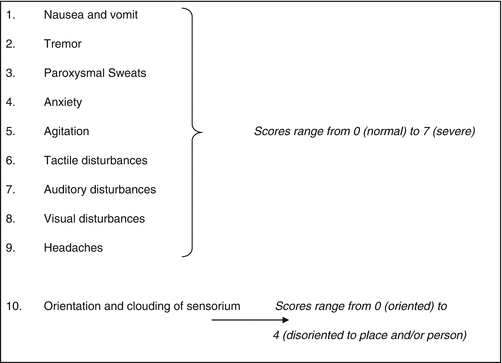Alcohol withdrawal:
Delirium:
A. Discontinuation of prolonged heavy alcohol intake
B. At least two of the following symptoms:
Autonomic hyperactivity
Hand tremors
Insomnia
Nausea or vomit
Transient hallucinations or illusions
Psychomotor agitation
Anxiety
Generalized tonic clonic seizures
Decreased attention or awareness
Disturbance in attention, awareness, memory, orientation, language, Visuospatial ability, perception, or all of these abilities that is a change from the normal level and fluctuates in severity during the day
Disturbances in memory, orientation, language, visuospatial ability, or perception
No evidence of coma or other evolving neurocognitive disorders
Predictors of delirium tremens: [1]
CIWA-AR scores > 15
Tachycardia (heart rate > 100 bpm)
Hypertension (systolic blood pressure > 150 mmHg)
Older age
Recent or prior seizures/AWS
Recent misuse of other depressant drugs
Electrolyte abnormalities
Other comorbidities (cardiac, pulmonary, gastrointestinal)
Principles of Management
Diagnosis
Alcohol withdrawal is a clinical diagnosis based on appropriate patient history and symptoms, with reasonable exclusion of other etiologies (e.g. infectious workup if patient presents with fever). Patients should have a history of chronic alcohol abuse with a recent abrupt reduction in intake. The symptoms of alcohol withdrawal can be divided into three broad categories: CNS excitation, autonomic hyperactivity, and psychosis. CNS excitation occurs 12–48 h following alcohol cessation, and is due to decreased inhibitory tone of the γ-amino butyric acid (GABA) receptor, and increased excitatory activity of the N-methyl-aspartate glutamate receptor (previously suppressed by alcohol intake). The patient may present with anxiety, agitation and restlessness, which, if left untreated, can progress to seizures. Most of the seizures are self- limited but can progress to status epilepticus. Autonomic hyperactivity typically occurs 24–48 h following alcohol cessation and is related to increased noradrenergic response. The patient may experience fevers, tachycardia, hypertension, diaphoresis and fevers. Psychosis occurs due to excess dopamine release through the mesolimbic tract. The patient will show confusion, hallucinations, and paranoia [3, 7].
Initial Phase of Care
The management of alcohol withdrawal is directed towards alleviating symptoms of withdrawal and avoiding its progression into seizures or DTs. For patients with marked alteration in mentation, hemodynamic instability, or those requiring frequent nursing assessment and intervention, ICU admission is suggested. Due to disease and medication related alterations in mentation; patients may require endotracheal intubation for airway protection. Benzodiazepines (e.g. lorazepam, diazepam) remain the first line of treatment, and are typically given intravenously to patients requiring ICU monitoring. Initially, a symptom-triggered escalating dose strategy has been shown to reduce the duration of therapy and the total dose of the medication given [8]. The goal of this protocol is to rapidly increase the doses until a desired level of sedation is achieved, before severe agitation occurs (Table 92.3). In cases of DTs, continuous benzodiazepine infusion may be required to alleviate symptoms [1, 7, 9, 10]. As propylene glycol toxicity may occur with high doses of IV lorazepam, it is recommend to check serum osmolarity (Osm) and the osmolar gap in these patients, and to stop the infusion if serum osm >350 mOsm/kg or serum osmol gap >10 [10, 11].
Drug | Loading dose | Repeated dosing regimen if ineffective |
|---|---|---|
Diazepam | 5 mg IV | 1. Repeat dose of 2.5 mg IV in 10 min, then 2. Administer additional 2.5 mg dose, then 3. Repeat dosing every 10 min increasing to 5 mg, then 10 mg, then 20 mg as is needed |
Lorazepam | 1–4 mg IV | 1–4 mg IV every 5–15 min, can repeat hourly |
1–40 mg IM | Repeat 1–40 mg IM | |
Phenobarbital | 260 mg IV | 130–260 mg IV every 15–20 min |
Propofol | Can be bolused and/or administered as an infusion (5–80 ug/kg/min) | |
Haloperidol | 0.5–5 mg IV/IM every 30–60 min | |
Dexmedetomidine | Infusion: 0.2–0.7 ug/kg/h, with no bolus. | |
The goal of care must also include nutritional supplementation and hydration, with emphasis in avoiding excessive fluid administration. Blood glucose and electrolytes must be monitored closely. Thiamine (500 mg IV once or twice a day for 3 days) is recommended to prevent the development of Wernicke encephalopathy, and it’s particularly important to be given before the administration of IV dextrose, as the latter can precipitate acute thiamine efficiency [1, 9, 10].
Stay updated, free articles. Join our Telegram channel

Full access? Get Clinical Tree








